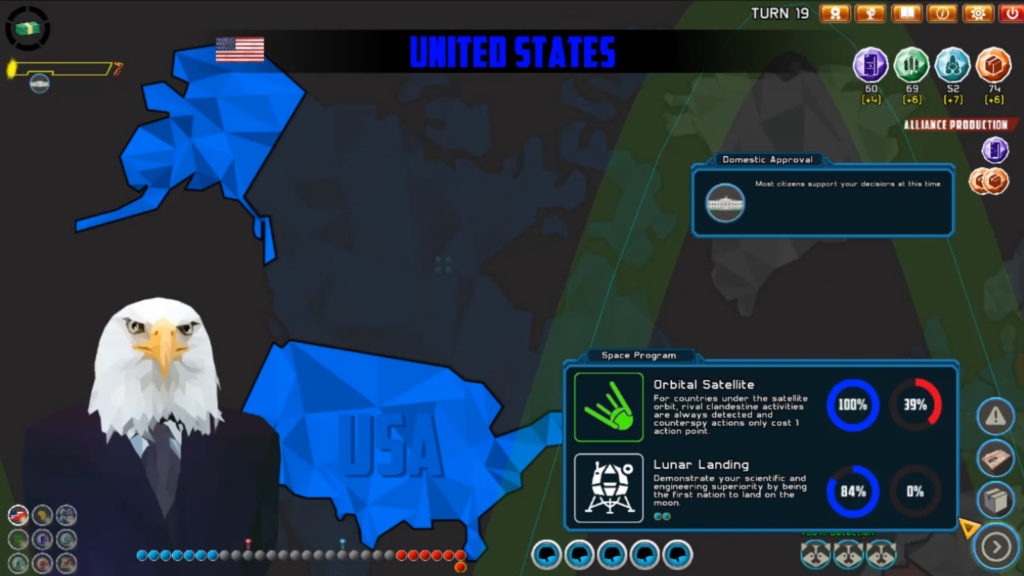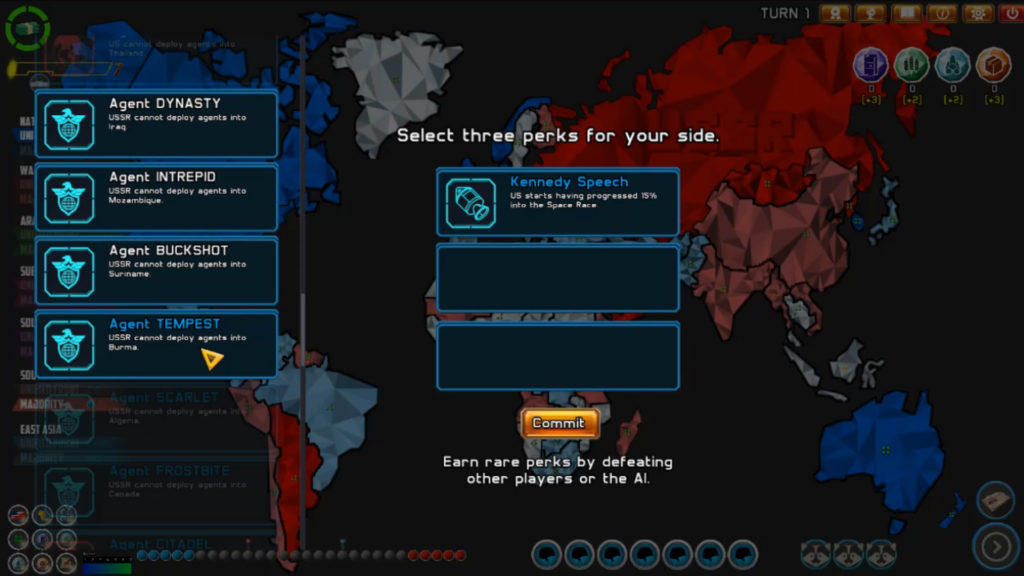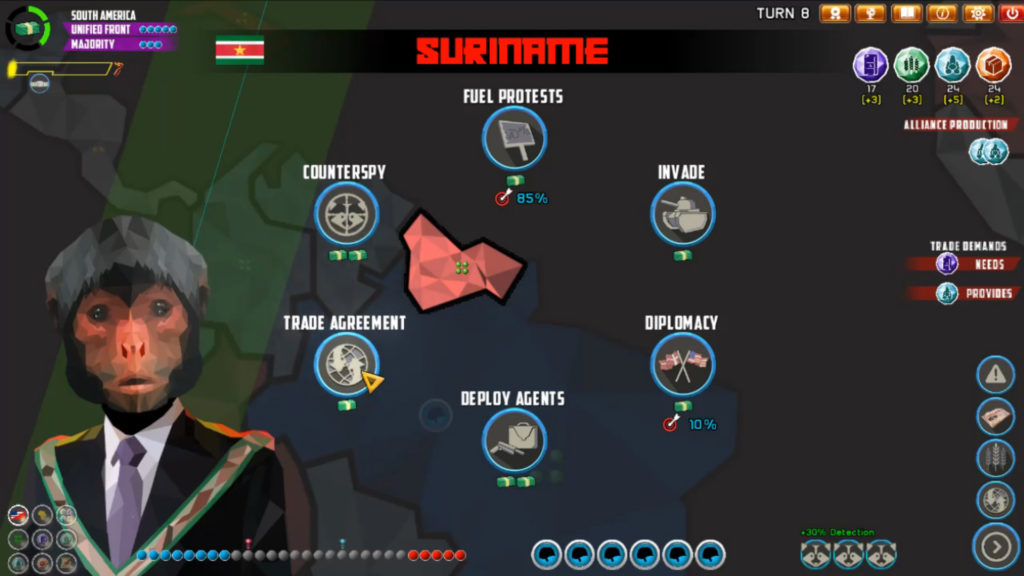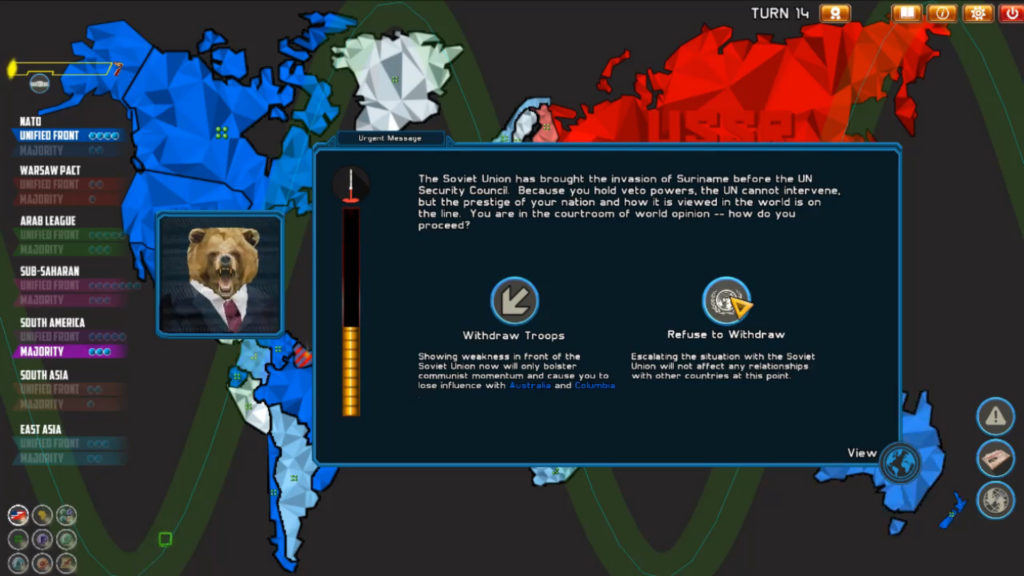
Precipice – Review
Precipice is not a war game, as the game itself states. Should it come to war, total annihilation will be the final result, and everybody loses. In this game you play as either the United States or the Soviet Union, simulating the cold war. The only way to win this game is to gather victory points by convincing enough countries to swear allegiance yo your side and prevent nuclear war by not escalating any conflicts too much. This game has been developed and published by LRDGames, Inc.
Story
The story of this game is basically world history itself. You play as either Russia or the United States at the beginning of the cold war. Through your actions, you’ll try to get as many countries as possible to back you as a superpower, but don’t rub the other power the wrong way, or it may mean total annihilation for the both of you!
Graphics
The graphics are simple: you are mostly looking at a world map. The USSR is represented in red, the USA in blue. 72 countries of the world are either neutral (white) or red or blue in different shades, depending on how strong their allegiance is. All countries have their leaders represented as an animated animal. The UI is pretty insightful, but when you are starting out, it’s a lot to take in and it’ll take a while to find what you can do.
Sound
There’s a looping background track, and the actions you do have fitting sounds as well. The game does not have any narration, but it doesn’t need anything more in terms of sound than it already has.
Gameplay
Precipice is a strategy game, simulating the cold war. This game really feels like a board game: at first glance, it might remind you of Risk, but in this case, the actions and strategies you can use to get countries over to your side are much more varied. You can play against a -rather challenging- AI, or even play against real humans via multiplayer mode.
Each round you have five actions you can spend. You can use these on things like conducting diplomacy with a country, organizing a trade deal, invading a country with no enemy troops in it, inciting riots, funding rebels, assassinating enemy spies, and taking part in the space race. You can take as long as you want for your turn.
As you start, you can choose three perks. These perks generally revolve around spy activity: it’ll be easier to detect spies within certain territories, or the perk prevents your opponent from deploying a spy in certain countries.
You got limited resources to spend, but you can invest in growing these resources by setting up trade deals with countries. Every now and then you’ll be able to send a number of resources to aid a country, which really helps to convince them to join your side. Troops are also a limited resource, you can deploy them to countries you don’t want your enemy to take, but you can only protect a few countries this way.
Whenever you click a country, you’ll see different options of what you can do in that country. Your goal is to build alliances with as many countries as possible, but your opponent will try to do the same. There are several ways to approach this: peacefully, through diplomacy, trade deals and sending resources, or aggressively, by sending spies and let them create political unrest. You can also invade a country, but your opponent will be able to challenge you or fund and/or train the rebels in the country you invaded. Countries also have dots in them, representing how politically stable that country is. If you create instability with your spies, you can eventually install a leader who will be loyal to you. You can also invade a country directly, but it is possible your enemy will challenge you, or you’ll get unrest at your home country or in other countries. Of course, you’ll also be able to challenge your enemy when he invades a country. However, always challenging his actions is pretty risky as well, since there’s a chance he won’t back down and if you let it go, you’ll lose influence as well.
You have three spies you can deploy to several countries, and the enemy will have three spies as well. These spies will be able to fund insurgencies or fuel protests. Without a spy, you will only have more peaceful options to sway a country to your side, but these tactics are usually a whole lot safer, and in the long run more successful. Spies can start protests, fund rebels, and even stage a coup, so they are powerful players. However, they can be assassinated, and you’ll never get any more spies within one playthrough. Killing the spies of your enemy will give you quite an advantage, so you should try to locate them. In order to do so you should watch the event logs and diplomatic shifts, to see in which country a spy could be active. You can use your actions to try to find and kill the spy within a country. If you picked the country where the spy is indeed active, the spy will be assassinated.
You can escalate conflicts within other countries. But if your opponent asks you to back down and withdraw your troops, you will be at a stand-off: you can withdraw and look bad in front of other countries, or stay your ground, but risk a nuclear war. If you escalate too often, you’ll have a nuclear war happening, and the game will end with mutual destruction: everyone loses.
You will win when you have gotten a certain number of victory points, or when the game ends after 50 turns, and you have gathered more points than your opponent. Points are won by controlling certain areas, or specific groups of countries. You can participate in the space race for points as well, and try to be the first to launch a satellite or land on the moon. There are also several world events which pop up during the game, which can win you points or influence in certain countries. The full 50 turns take approximately one hour, so the playtime of this game is not too long. However, you cannot save mid-game, so be prepared to play for an hour. If you play non-aggressively, you’ll often take the full 50 turns. However, it does seem this tactic has a better chance of winning than playing aggressively and hope for your enemy to back down all the time.
Conclusion
Precipice is a great game for people who love strategic board games. The game is easy enough to get the hang of, but after a few rounds you’ll learn it’s actually pretty hard to win, and you’ll most likely have to adjust your strategy a few times in order to get a chance at winning. The combination of the many different strategies you can use, and RNG, make this game challenging and often quite thrilling, whether you play against the AI or a real person.
Precipice - Review,











No Comments